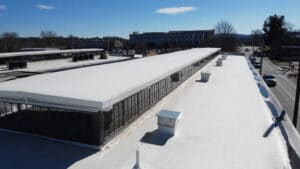Flashing & Waterproofing Lines Through Flat Roofs
Flashing & Waterproofing Lines Through Flat Roofs
WNC Roofing specializes in reroofing commercial buildings; unsurprisingly we are routinely presented with “interesting” situations that need to be corrected and brought up to code during the reroof process.
We are experts at designing systems that will allow both service work and future upgrades to be performed without compromising your new roof.


Left Photo Above: When these lines were run little thought was given to how the penetrations might be properly flashed and made watertight or as to how future HVAC or roofing service work could be performed.
Right Photo Above: This is an image of a “Line Shack” which is an excellent solution for routing multiple lines. Your roofer can easily flash them in watertight and they allow HVAC techs easy access for service, modifications and additions.
Rooftop Penetrations:
- Perhaps the number one complaint building owners have about their existing roofs are ongoing tenant complaints and damage caused by leaks around curbs and penetrations that they’ve been chasing for years but haven’t been able to permanently solve.
- Penetrations for electrical lines, refrigerant lines and ductwork are often unavoidable, especially when HVAC units sit atop the roof.
- When preparing to install a new roof system on your building (which may have a life expectancy of 30+ years), It is prudent to compare the service life of the new roof against the life expectancy of your existing equipment.
- WNC Roofing will work with you to design a roof system that will allow HVAC contractors to perform service work and future upgrades without compromising your new roof which will remain watertight and trouble-free.
Sealant Pockets:
- Sealant pockets are commonly utilized because they are much more economical than installing a Line Shack style housing. They do have some disadvantages:
- They don’t allow for service or for work on future system modifications.
- They are not the most enduring option. When a workmanship warranty is purchased, manufacturers will warranty them for up to 20 years, whereas other flashing options are warrantable for up to 30 years.
- Sealant pockets are the most complex flashing option and are often improperly installed by careless or poorly trained contractors.
- The drawing above shows a properly installed penetration pocket.
- NOTE: There is a 1” gap between each of the pipes and also between the pipes and the edges of the sealant pocket. This is critical for longevity as expansion, contraction, and movement will occur. Without these gaps, there would not be an adequate amount of flexible fill material to be able to stretch with the movement. This causes gaps (aka leaks) to open between the pipes and fill material.
- NOTE: The fill material is rounded over creating a crown at the top. This is designed to shed water, minimizing infiltration as the sealant ages and fails. This also prevents damage from water freezing and expanding as it turns to ice in the winter.
- In addition to the drawing above the manufacturer provides a three-page guide on proper installation.
Sealant Pockets: Photos of Improper Work
Unfortunately, photos like the ones below are all too common sights on roofs. Often when they are blatantly visible issues like these, many other mistakes and shortcuts (both visible and hidden) are present.
A properly designed installed and maintained (60 Mil) membrane roof (TPO / PVC / EPDM) should provide a trouble-free service life of 25 or more years.




“J” Housings:
- When a small number of lines need to be run, a “J” or candycane-shaped housing can be utilized.
- PVC piping is commonly used because it’s readily available. The downside of using PVC is that UV radiation from the sun will degrade the material causing it to become quite brittle over time.
- Housings made from black ABS pipe are recommended.


Installation: Line Shack or “J” Housing
When electrical and refrigerant lines are involved, WNC Roofing will hire and supervise a licensed HVAC contractor to perform specialty work.
-
- HVAC units will be tested prior to commencing work. A report will be provided detailing any deficiencies.
- Refrigerant lines will be drained and all refrigerant will be recovered per EPA regulations.
- Electrical lines will be disconnected and extended as required.
- If required safety disconnects are not present, they will be added per electrical code.
- New slips sheets (an extra layer of roof membrane) and new pressure-treated blocking will be installed underneath freestanding units.
- Line shack housings or “J” housings will be installed.
- Refrigerant lines will be extended as required and the HVAC units refilled with refrigerant.
- Startup testing will be performed per manufacturer’s requirements.



